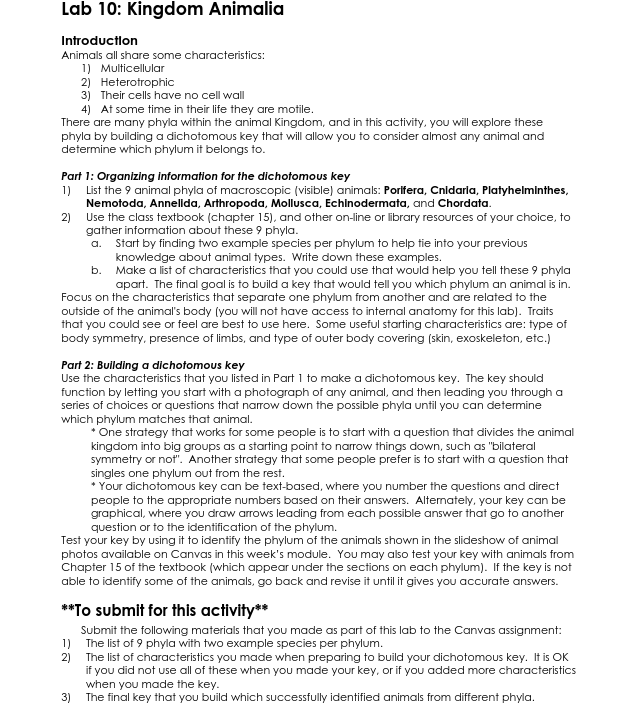The list of 9 phyla with two example species per phylum. 2) The list of characteristics you made when preparing to build your dichotomous key. It is OK if you did not use all of these when you made your key, or if you added more characteristics when you made the key. 3) The final key that you build which successfully identified animals from different phyla.
Lab 10: Kingdom Animalia Introduction Animals all share some characteristics:
1) Multicellular
2) Heterotrophic
3) Their cells have no cell wall
4) At some time in their life they are motile.
There are many phyla within the animal Kingdom, and in this activity, you will explore these phyla by building a dichotomous key that will allow you to consider almost any animal and determine which phylum it belongs to.
Part 1: Organizing information for the dichotomous key 1) List the 9 animal phyla of macroscopic (visible) animals: Porifera, Cnidaria, Platyhelminthes, Nemotoda, Annelida, Arthropoda, Mollusca, Echinodermata, and Chordata. 2) Use on-line or library
a. Start by finding two example species per phylum to help tie into your previous knowledge about animal types. Write down these examples.
b. Make a list of characteristics that you could use that would help you tell these 9 phyla apart. The final goal is to build a key that would tell you which phylum an animal is in. Focus on the characteristics that separate one phylum from another and are related to the outside of the animal's body (you will not have access to internal anatomy for this lab). Traits that you could see or feel are best to use here. Some useful starting characteristics are: type of body symmetry, presence of limbs, and type of outer body covering (skin, exoskeleton, etc.)
-------------------------
Part 2: Building a dichotomous key Use the characteristics that you listed in Part 1 to make a dichotomous key. The key should function by letting you start with a photograph of any animal, and then leading you through a series of choices or questions that narrow down the possible phyla until you can determine which phylum matches that animal.
* One strategy that works for some people is to start with a question that divides the animal kingdom into big groups as a starting point to narrow things down, such as "bilateral symmetry or not". Another strategy that some people prefer is to start with a question that singles one phylum out from the rest.
* Your dichotomous key can be text-based, where you number the questions and direct people to the appropriate numbers based on their answers. Alternately, your key can be graphical, where you draw arrows leading from each possible answer that go to another question or to the identification of the phylum.
-------------------------
Submit the following materials: 1) The list of 9 phyla with two example species per phylum. 2) The list of characteristics you made when preparing to build your dichotomous key. It is OK if you did not use all of these when you made your key, or if you added more characteristics when you made the key. 3) The final key that you build which successfully identified animals from different phyla.

Step by step
Solved in 4 steps with 1 images








